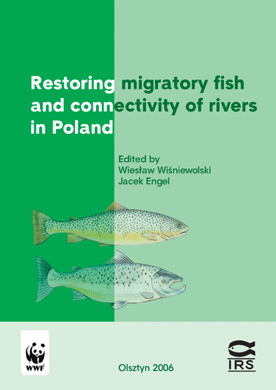Restoring migratory fish and connectivity of rivers in Poland, 2006 - Edited by Wiesław Wiśniewolski and Jacek Engel, Wyd. IRS i WWF Polska, s. 82
1.1. Introduction
The progress of civilization in the nineteenth and twentieth centuries has improved the standard of living of urban communities throughout the world. This has also resulted in the serious problem of the anthropogenic transformation of running waters.
The pollution, regulation, and fragmentation of rivers have led to either the disappearance of or drastic reduction in the abundance of populations of fish with highly specific habitat requirements (Bless 1978, Penczak 1988, Penczak et al. 1996, Witkowski 1996). Populations of migratory fish have become the most endangered as their life cycle requires them to undertake spawning migrations between marine and inland waters. Regulation and damming has terminated access to spawning grounds that are frequently located in the middle and upper reaches of rivers. Many populations have died out or found themselves at the brink of extinction (Backiel 1993, Buras et al. 2001, Wiśniewolski 1985, 1987, 1992a, Wiśniewolski et al. 2001a, Witkowski 1996).
The negative impact of these transformations is the impetus behind widespread attempts to restore the high natural values of riparian environment (Bless 1985, Gebler 1991, Krüger et. al. 1993, Seehorn 1992, Wiśniewolski 1997). Ichthyofauna has played a significant role here since the species and abundance structure of fish assemblages is viewed as the best bioindicator for providing information regarding the condition of aquatic ecosystems. Ichthyofauna assemblages reflect not only temporary, incidental occurrences but can also be used to track long- term changes that are difficult to perceive in the short-term (Bauch 1958, Denzer 1966, Jokiel and Backiel 1960, Wiśniewolski 1987).
The impact of variety of factors shapes ichthyofauna assemblages (Bless 1978, Wiśniewolski 2002). In the long-run, however, river obstructions have the most drastic impact since they disrupt the ecological continuity of these ecosystems (Backiel 1993, Bartel 2002b, Wiśniewolski 1985, 1992). The fundamental condition for the success of increasingly wide-ranging steps to restore migratory fish species in areas of their historic occurrence is opening migratory routes and providing free access to spawning grounds (Sych 1998). This is accomplished by removing obstacles and building passes and other fishways to allow fish migration (Gebler 1991, Krüger et al. 1993, Wiśniewolski 1997, Wiśniewolski 2003). These actions must be accompanied by the complex protection of the remaining wild broodstock populations and their spawning grounds, by rearing their young generations as well as strengthening or rebuilding these populations through stocking with fish reared under controlled conditions. This type of work has long been undertaken in Poland, and in 1996, it was placed under the co-ordination of the Program to restore migratory fish in Poland (Sych 1998, Bartel 2002a). The aim of this monograph is to present the current situation of Polish populations of sturgeon, Acipenser sturio and A. oxyrhynchus; salmon, Salmo salar; sea trout, Salmo trutta trutta; and vimba, Vimba vimba, as well as to examine the possibilities of their restoration in light of current conditions that result primarily from the anthropogenic transformation of riparian ecosystems.
Contents
1. Introduction 5
1.1. Introduction (W. Wiśniewolski) 5
1.2. Status of sturgeon, salmon, sea trout, and vimba in Poland (R. Bartel, R. Kolman, W. Wiśniewolski, A. Witkowski) 6
1.3. Causes for decline in abundance or extinction of anadromous fish (W. Wiśniewolski, A. Witkowski) 15
1.4. Current state and future of populations included in the migratory fish restoration program (R. Bartel, R. Kolman, P. Dębowski, R. Depowski, M. Klich, L. Augustyn, W. Wiśniewolski, A. Witkowski) 22
2. Environmental conditions for restoration success 29
2.1. River passability as a fundamental condition for fish migration (W. Wiśniewolski) 29
2.2. Obstacles to fish migration and existing fish passes 32
2.2.1. Upper Vistula basin (L. Augustyn, R. Bartel, R. Depowski, M. Klich) 32
2.2.2. Middle Vistula basin (R. Bartel, W. Wiśniewolski) 37
2.2.3. Lower Vistula basin and the rivers of the Vistula Lagoon and Central Pomerania (R. Bartel, P. Dębowski, W. Wiśniewolski) 37
2.2.4. Basin area of Western Pomerania (R. Bartel, P. Dębowski) 44
2.2.5. Upper and Middle Oder basin (according to Szymanowski et al. 2002) (A. Witkowski) 45
2.2.6. Lower Oder basin including the Warta River (A. Witkowski, R. Bartel, W. Wiśniewolski) 46
2.3. State of spawning grounds 47
2.3.1. Historical distribution of spawning grounds (R. Bartel, L. Augustyn, R. Depowski, M. Klich, R. Kolman, P. Dębowski, W. Wiśniewolski, A. Witkowski) 47
2.3.2. Current state and accessibility of spawning grounds (R. Depowski, M. Klich, P. Dębowski, R. Kolman, A. Witkowski) 50
3. Will restoration succeed? (R. Bartel, W. Wiśniewolski, A. Witkowski) 59
4. Recommendations for the restoration program (R. Bartel, R. Kolman,
W. Wiśniewolski, A. Witkowski) 65
5. Anticipated results (R. Bartel, W. Wiśniewolski, A. Witkowski) 71
6. Conclusions and recommendations (R. Bartel, W. Wiśniewolski, A. Witkowski) 73
7. References 75